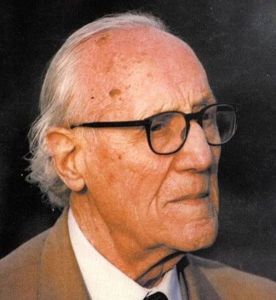Painter, Poet and Historian
Alberto Carlo was born in Sanremo to Giovanni Battista and Maria Asplanato on 26 November 1900, in Via Palma. Son of art, as his father had been the author of many Art Nouveau decorations in the most beautiful villas of the town, he approached the world of painting from a very young age until he attended the 'Accademia di Belle Arti di Genova': he soon learned the technique of colour by observing the many English artists who were present in Sanremo at that time. He made friezes of some villas in Sanremo, then he moved decisively to the representation of views of our city, in particular the Pigna with its suggestive corners. A vast production of watercolours and oil paintings remains.
Very sensitive to traditions, he worked in many initiatives to divulge the town's memories: he founded the Sanremese Folklore Group, equipping it with typical costumes reconstructed according to his studies.
At the beginning of the Thirties, together with Duke Michele Borea d'Olmo, the lawyer Nino Bobba, Dr. Giovanni Guidi, the engineer Stefano Canepa, the painter Alberto Beltrame and the architect Silvio Gabrielli, he founded the 'Arts and Traditions Committee', with the aim of safeguarding the artistic and monumental heritage of the city.
During the Second World War he had saved the statue of Garibaldi sculpted by Leonardo Bistolfi, destined to be melted down to obtain metal for war purposes. In December 1959 he vigorously opposed the attempted demolition of the Bastion of Ciapella (better known as the 'Saracen Tower') in Piazza Eroi Sanremesi.
In the immediate post-war period he had also intervened to prevent the precious altar of the Grimaldis of Monaco, already belonging to the church of the Salesians in piazza Colombo (which was destroyed during the bombardment of 20 October 1944), from being bought and transferred to Venezuela, and which currently has a beautiful presence in the Sanctuary of the Madonna della Costa.
In 1943 he had also revived the Consorteria dei Consoli del Mare, an ancient maritime institution run by two consuls, who had been in charge of regulating maritime traffic since the 17th century.
He had also actively cooperated with the International Institute of Ligurian Studies and had had frequent contacts with Professor Nino Lamboglia, in order to better protect the local artistic and historical heritage. In 1981 he founded the 'Circolo Ligustico Arte e Ambiente', which became a valid instrument for the valorisation of the historical-artistic patrimony of Western Liguria.
Also in 1981 he found, in the basements of the Villa Comunale and the Civil Hospital, paintings by Poussin, Salvator Rosa, Grosso, Ferrari and Grechetto, cataloguing them. It is also due to him the recovery of the large canvas depicting St. Napoleon, hidden in the Sanctuary of the Coast and now on display at the Civic Museum. He had also recovered a bust of the podestà Pietro Agosti in San Romolo, a portrait on canvas of the lawyer Costanzo Balestreri, and the plinth of the 19th century fountain, which served as a pedestal for the statue of Siro Andrea Carli, in via Padre Semeria. Behind his proposal was also opened the new seat of the Civic Museum in Palazzo Borea d'Olmo in via Matteotti in 1983.
He died in Sanremo on 23 May 1987.
From the columns of the "Echo of the Riviera" he had led a strenuous battle to defend the "old" Sanremo from the invasion of the cement that was advancing inexorably and without control. He had also written lyrics for songs, set to music by the masters Marabotto, Panizzi, Feriati and Valcasara; he also organised local celebrations and art exhibitions such as those of the Miniature Fleet, held in October 1966, of Christ in Art and the Effigies of the Madonna della Costa, preserved by private individuals. For his artistic and cultural merits he was nominated 'Meritorious Citizen' of Sanremo in 1975, while on 25th October 1953 he was awarded the title of 'Honorary Citizen' by the Municipality of Sanremo.
(source: Andrea Gandolfo)





